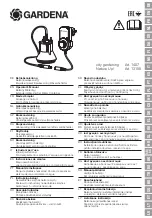
TLS 216 User Manual
3–117
Selecting Groups and Channels
The TLS 216 Logic Scope applies the control changes you make, such as vertical
bandwidth, offset, position, and scale, to the selected group. To make these
changes to a group, or to define a group (choose the channels the group contains,
its display mode, and so on), you must first select it.
The logic scope also applies a limited number of control changes based on the
selected channel in the selected group. For example, Autoset, which automatical-
ly adjusts control settings based on the signals at its input channels, uses the
selected channel to determine the logic scope control setup. Also Measure, the
automatic measure feature, takes most automatic measurements on the selected
channel.
This article describes how to select a group and a channel within a group. To
read more articles that explain other key concepts about working with groups,
see To Find More Information on page 3–120.
To Check Which Group is Selected
To quickly determine which group is selected, always look at the Vertical
Readout. It always displays the selected group, with its group label shown in
reverse video. See Figure 3-55.
NOTE
. The vertical readout varies its display according several rules. Read the
description To Check Group Settings on page 3–56 to become familiar with this
readout.
To Select a Group
Use the group selection buttons, to the right of the display, to select from groups
1 through 8 and to display the Group More menu. (Pressing MORE displays a
menu for selecting internally stored Ref waveform groups for display and
manipulation.) Do the following procedures to select a live or reference group.
To select a live waveform group (one that can acquire waveforms as opposed to a
reference waveform group that can only store and display them) do the following
steps.
1. Press any of group selection buttons GROUP 1 through GROUP 4 on the
right side of the display to select any one of groups 1 – 4.
Selecting Acquisition
Groups
Summary of Contents for P6240
Page 5: ......
Page 7: ......
Page 15: ...Table of Contents viii TLS 216 User Manual...
Page 20: ...Getting Started...
Page 26: ...Start Up 1 6 TLS 216 User Manual...
Page 51: ...Operating Basics...
Page 53: ...Overview 2 2 TLS 216 User Manual...
Page 73: ...Acquisition 2 22 TLS 216 User Manual...
Page 82: ...Reference...
Page 94: ...Adjusting the Vertical Setup 3 12 TLS 216 User Manual...
Page 104: ...Choosing an Acquisition Mode 3 22 TLS 216 User Manual...
Page 112: ...Choosing a Group Display Mode 3 30 TLS 216 User Manual...
Page 122: ...Customizing the Display 3 40 TLS 216 User Manual...
Page 130: ...Customizing the Display Colors 3 48 TLS 216 User Manual...
Page 162: ...Measuring Waveforms Automatically 3 80 TLS 216 User Manual...
Page 168: ...Measuring Waveforms with Cursors 3 86 TLS 216 User Manual...
Page 178: ...Printing a Hardcopy 3 96 TLS 216 User Manual...
Page 186: ...Probing of Circuits 3 104 TLS 216 User Manual...
Page 198: ...Saving and Recalling Waveforms 3 116 TLS 216 User Manual...
Page 222: ...Triggering on Patterns 3 140 TLS 216 User Manual...
Page 252: ...Triggering on States 3 170 TLS 216 User Manual...
Page 256: ...Viewing Status 3 174 TLS 216 User Manual...
Page 261: ...Appendices...
Page 283: ...Appendix B Algorithms B 18 TLS 216 User Manual...
Page 285: ...Appendix C Packaging for Shipment C 2 TLS 216 User Manual...
Page 290: ...Glossary...
Page 302: ...Glossary Glossary 12 TLS 216 User Manual...
Page 303: ...Index...
Page 319: ...Index Index 16 TLS 216 User Manual...
Page 320: ......
Page 321: ......
















































